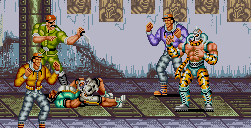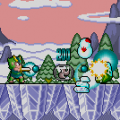Original content in games is hard to create, but lots of games are decidedly derivative of more famed titles that came before it. In the side-scrolling beat-em-up field, the most emulated was Final Fight, which in itself was even influenced from Double Dragon, where two players team up to get back one of the character’s girlfriend by whomping on punks in an urban cityscape. Nevertheless, Final Fight led to multiple clones based on its atmosphere and gameplay, and we got some great games out of this hence. The most famed clone was Sega’s Streets of Rage, which was clearly akin to Final Fight but nobody cared because it was awesome.
Sega produced another arcade-exclusive brawler called D.D. Crew, but it sucked royally compared to Streets of Rage and was best left forgotten. However, they also teamed up with Westone, their second-party development crew best known for the Wonder Boy anthology, and produced a little known game called Riot City. It is, without any doubt, one of the most severely blatant Final Fight-inspired games of all time (perhaps more so than Jaleco’s first Rushing Beat / Rival Turf!) and careens full tilt into “ripoff” territory. But if imitation is said to be the sincerest form of flattery as per a familiar idiom, how flattering does Riot City feel beneath its parent? The short answer: Okay, not great.
The game is about two narcotics detectives, the dashing Paul and the bulky Bobby, determined to stop the Mad Gears… erm, the drug syndicate “MID.” Their resolve is hastened tenfold when Paul’s girlfriend, Catherine, is kidnapped by MID agents and the two cops storm the baddies’ hideout in Riot City, out on an island. Naturally, despite being talented police officers, Paul and Bobby choose to dress like a gym trainer and a street dancer respectively. Unsurprisingly, Paul bears incredible semblance to Cody from Final Fight, what with the jeans and the white shirt and the fabulous blond hair, but Bobby at least looks like no one from Final Fight.
As with any good beat-em-up, you can team up with a friend to wreak two-player havoc on the forces of MID. The two guys actually have very slightly different stats, where Paul is faster and Bobby is slower but stronger, although these differences are ultimately negligible. However, if you’re not playing with a buddy, be Bobby. The absolute best thing about Riot City is Bobby’s absolutely loopy walking animation, where he dance-stomps around the screen as if he was MC Hammering-it-up in an attempt to confuse the enemies. Paul’s perpetually grinning strut is also pretty amusing and exaggerated, but it’s got nothing on Bobby’s bombastic bump-a-thump walk.
Anyway, once you get to Riot City, it’s time to start bashing up punks. You know the drill – there’s a standard combo string that knocks down enemies at the end, jump attacks which instantly knock down but don’t do too much damage, and a “get-offa-me” attack done by pressing both the attack and jump button together at a slight cost of your lifebar. Unfortunately, there are absolutely no spare weapons to be found (not even throwing knives), so this is basically all there is for offense.
The enemies come in a fair blend: Kung fu fighters, standard surfer punks, fat cowboys, football players, tall mustache guys in tank tops, toughs aping Mr. T’s style, Saddam Hussein-looking commandos with knives and eyepatches, and the most obnoxious being truckers who slide and seem to have an easy time punching you out of the air. While this is a good mix of baddies to fight, the problem is you literally fight all of these schmucks in the first level and you have to deal with them for the rest of the game. Beat-em-ups often have the common problem of showing off all their cards too early, but at least Final Fight waited until the second level to plague you with Andore.
If nothing else, the bosses breathe some variety into the fold, such as a rather cocky Thai boxer, the obligatory Bruce Lee homage (the second boss of D.D. Crew was also a Bruce Lee clone, oddly enough), an insane doctor who chops at you with a cleaver, a masked wrestler who puts his horns to good use, an even bigger wrestler who may be a homage to Heart from Hokuto no Ken, and the final boss greatly resembling Geese Howard from Fatal Fury. His name is Dick, and he uses a fencing sword to unfairly slice off your lifebar. Except for the final one, they’re not incredibly cheap and provide some necessary variety from the conventional dreck.
There’s really not a lot to Riot City; you just sock it to street scum for five increasingly difficult rounds. It’s not a bad game, but it’s really only interesting for how much like Final Fight it is, like how you see a map of the city before and after each round, how you start on street slums and end up in a lavish palace by the final round, and how much Paul resembles Cody. The big fat cherry to top it off is how bosses spaz out and jerk around for several seconds before dying, instead of just straight plopping onto the ground. While these are all relatively small touches, it’s hard not to think of how Final Fight didn’t massively inspire these details. There are a couple of neat twists though. During the fight with the second level boss, everyone falls off the rooftop and you continue fighting on the ground. While like the third level of Final Fight, there’s a hidden lair underneath a bar, this time it’s filled with Satanic imagery. And the final stage takes on a lavish Japanese theme, rather than the Western decadence of Belger and pals.
The visuals are only average, with the graphics being serviceable but nothing special, and most of the environments coming off as a bit drab (though the casino in stage 4 looks pretty neat, at least). Character sprites aren’t as large or animated as in Final Fight either. The music’s pretty good, handled by Jin Watanabe of Monster World IV fame, but all the same, it’s nothing that will get stuck in your head for any extended period of time.
For as vanilla as it is, Riot City somehow landed a console port on the unlikely TurboGrafx-16 CD format, making it one of the few beat-em-ups on the playform. In North America, it’s known as Riot Zone, while the Japanese version is known as Crest of Wolf. The port was handled by Hudson Soft, though many of the graphics have been redrawn.
While it is mostly the same game at its base, a few notable changes were made, most noticeably to all the character sprites. Paul is now “Hawk Takezaki,” who still looks very similar but has even simpler clothes which make him resemble Cody even more, and Bobby has been changed into a mohawk dude named “Tony Aldus.” The kidnapped heroine is now named Candy, and the bad guys are known as JADOH. The story has been changed around a bit too, with different intro cutscenes. In the arcade version, the two cops simply heading off to Riot Island to beat some skulls. The console version explicitly takes place in New York City, while Hawk and Tony storm into their police chief’s office to demand a warrant to investigate the DragonZone. The chief refuses, so Hawk and Tony quit the police force to fight off the bad guys instead. There’s no mention of any “Riot City”, so this probably accounts for the title change.
The enemies have been completely changed around, such as the sliding truckers now looking like Shaolin monks and the knife commandos being ninjas, but their behaviors are still akin to Riot City‘s bads. Most of the villains look less ridiculous than their arcade counterparts, and you even deal with female punks this time around, including one who is clearly based off Poison named Shauna. There’s even an all-new final boss, a totally ridiculous samurai warlord that’s almost out of place with the rest of the cast. There’s more emphasis on these foes, considering each level begins with a “wanted” poster of them. The backgrounds look mostly the same, though it’s worth noting that the order of the first two levels were switched around for reasons unknown.
Perhaps the biggest enhancement is all new redbook audio full of awesome cheesy nineties synth rock tracks provided by T’s Music. It’s nothing too catchy like the original arcade, but it’s a solid soundtrack that fits the game well. Riot Zone may seem like an overall improvement were it not for two caveats: The action is slower than the arcade, and actually drops to a lower frame rate any time enemies are present (though some may prefer the slower pace), and the port completely lacks two-player support. It’s also a bit easier, since there are less enemies on screen at the same time. This version has also been released on the Wii Virtual Console. Both Riot City and Riot Zone have their good points, but at the end of the day, whether arcade or TG16-CD, it’s an alright-at-best beat-em-up outclassed by most of its peers.
Screenshot Comparisons


